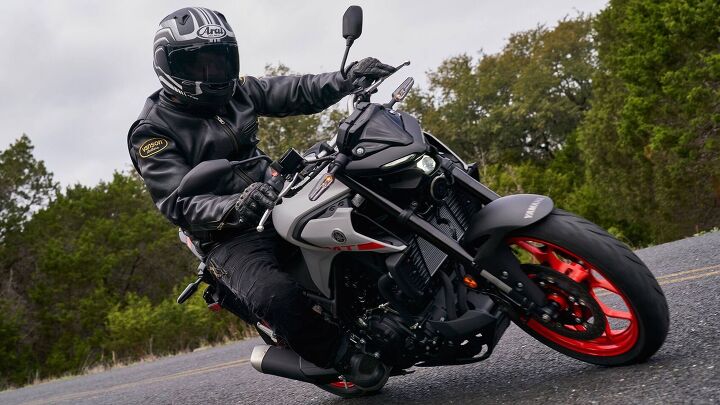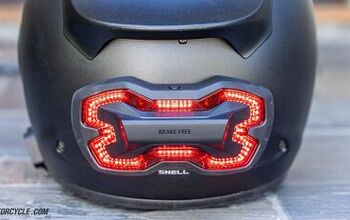How to: Motorcycle Braking

It may seem like voodoo, but good braking skills aren’t hard to develop.
When you’re first learning to ride, coordinating a motorcycle’s throttle, clutch, shifter, front brake, and rear brake can seem like a confounding task – and especially doing so smoothly. Fortunately, though, if you’re already a bicycle rider, the clutch and front brake levers will seem natural enough. (Until, of course, you notice that a bicycle’s front brake lever is on the left and the front brake lever on a motorcycle is on the right…but that’s a mystery we shall not address here.) Instead, let’s just discuss brakes and braking.
Your motorcycle – or your intended one if you’re shopping – will have some combination of hydraulic disc and/or mechanical drum brakes. Exceptions exist for older machines, but current machinery operates the front brake with the right-hand lever and the rear brake with a foot lever, also located on the right side. A few bikes, usually larger and more expensive models, have linked braking systems, wherein the brake pedal or the brake lever operates both rear and front brakes simultaneously. But since this is more the exception rather than the rule, this article on braking will focus solely on how to use typical front and rear brakes independently.
Motorcycle.com thanks Yamaha for sponsoring this new rider series.
Front Wheel Braking
Due to a phenomenon known as “weight transfer,” a motorcycle’s front brake does most of the braking. This is why the front brake is larger than the rear brake, why dual front discs are found on high-performance machines, and why front brake calipers are most often larger and utilize more pistons than rear-brake calipers. This is a clue to why you should become an expert at slowing and stopping using the front brake.
Now, we know some people are a bit apprehensive of using the front brake, thinking that they might “go over the bars” if they apply it too hard. (See ABS Braking below.) There’s no disgrace in that thinking. But if you’re one of those Nervous Nellies, rest assured, it would take a radical set of circumstances indeed for this to occur, and by learning proper braking technique, you decrease the chance of that happening.
Let’s explore a practice drill to get you more comfortable with using the front brake. You’ll need a smooth parking lot, cul-de-sac, long driveway or similar where you can practice safely – and make sure there’s ample room with nothing to hit. A coach or observer would be handy, too.
Place a cone or some other marker – even a chalk line drawn on the ground – in an open area of pavement. Now ride your motorcycle slowly (e.g., 5-10 mph) toward it and use that marker as a starting point for braking. Apply only the front brake gently, and get the feel of stopping that way. Do it dozens of times if you must. Eventually it will feel normal, and you’ll see that stopping with the front brake is safe and controllable.
From here, work the speed and lever pressure up until you’re braking harder, and probably stopping in a shorter distance. (Chalk the stopping positions if you like.) Attune your senses to the feel of the brake lever and the feel of the motorcycle under braking. As you improve, you’ll likely learn that smoothly releasing the lever as you approach a standstill affords a smoother stop.
The purpose of this section isn’t to teach high-performance braking or turn you into a stoppie maniac. It’s simply to help you experience that you and your bike can brake efficiently, confidently, and securely with the front brake alone. And we expect no skid marks occurred.
Rear Wheel Braking
If a bike does most of its braking with the front brake, why do motorcycles even need rear brakes? Our response: 1) Federal regulations; 2) Having a backup system; 3) To harness both tires for braking purposes if conditions demand it, such as an emergency; and 4) In some cases, to help steady the chassis.
You can try the same exercises noted above using the rear brake only. If you do this, we think you’ll find that as your drill works up to higher speeds, the rear brake does not offer the same effective braking result as you observed with the front brake. That should make you think….
When you’re fully confident and competent with the front and rear brakes individually, another layer of knowledge may be gained by repeating the exercises using both brakes simultaneously. At this point, you’ll see how well individual front and rear brakes really work together.
Trail Braking
There are some subsets – plenty of them, actually – in the physics and science of motorcycle braking. One is the art of “trail braking.” Essentially, this is braking into a corner. It may not seem like the most logical life decision, but there are good reasons to know about trail braking and ultimately, master it.
First, though, let’s run through a trail braking example. You’re on a mountain road and approaching a sharp turn. You brake and downshift but observe that your speed is still too high. What to do? There aren’t many choices: 1) Panic brake; 2) Lean into the turn at whatever speed you’re going and hope you “make it”; and 3) Continue braking, but gradually lessen the front brake lever pressure as you enter the turn, so that the bike continues to decelerate while the turn is being initiated. Reducing speed in this way buys you time and space on the road, and additionally, the forward pitch of the chassis under braking may sharpen the steering angle, helping the bike turn.
It’s a win all around if you master it and get it right. Professional training – for instance, at a track school – is advisable if you want to really get it right.
ABS Braking
ABS is found on certain motorcycles with front and rear disc brakes. In simple terms, using sensors, ABS continuously “counts” the rotational speeds of the front and rear wheels, and feeds that information, in real time, into an onboard microprocessor. When you brake in slippery conditions and one wheel and/or the other locks up, the computer notes impending lockup (and other factors) and directs a pump built into the brakes’ hydraulic system to “pulse” the piston(s) in the indicated brake caliper(s), creating a rapid “on and off” braking effect. Basically, this pulsation continues until the wheel rotational speed realigns with specified parameters, allowing the tire to regain and maximize grip instead of sliding. And so goes the great secret of ABS.
There’s every reason to be confident in ABS on a contemporary motorcycle. Even for experienced riders, it takes a pretty heavy hand to activate the ABS on the front wheel on dry pavement, and on wet or slippery pavement it works its magic automatically and wonderfully. If you’re aggressive with the rear brake pedal, though, it’s not uncommon for ABS to activate either on dry or wet pavement – in our experience, a matter of little concern.
Braking in the Rain
When the coefficient of friction (traction or grip, in more casual terms) is reduced, such as in the rain, there’s less available surface grip for your tires. Common sense tells us to slow down and to be gentle with the brakes here, and that’s why human nature is so good for us. Per the strategy mentioned above, when you’re riding in the rain, applying the rear brake momentarily before the front can be useful if you’re unsure of the available grip. This can help steady the chassis, and under certain circumstances – in a straight line please! – using the rear brake may help you “feel” for available traction.
Some racers look for a “rain line” in the wet. In doing so, they’re basically seeking corner areas (often outside the main cornering line) that are not coated with a layer of racing rubber that can bead water. Then, moving to a coarser bit of asphalt can reduce the chance of riding over such a boundary layer of water, which might cause a slip. We mention this not so you’ll enter a Grand Prix in a deluge, but to encourage you to look at the asphalt while you’re riding in the rain. When you are watching the pavement, you’ll probably notice that the car tracks in front of you are drier for a short time after the tires force the water away. Take advantage of this pavement. Braking is such a major skill for motorcyclists, we all need to find knowledge wherever we can. Never stop braking, never stop learning!

John L. Stein brings 30 years of both automotive and motorcycle experience, having written for AutoWeek, Car and Driver, Motor Trend, Sports Car International, Chevy Outdoors, Truck Trend, Cycle World, Motorcyclist, Adventure Travel, and Men’s Journal, just to name a few. His articles have been published in the US, England, Japan, Australia and France. His technical knowledge combined with his ability to understand and effectively communicate what a motorcycle is doing underneath him is an invaluable resource to the Motorcycle.com team.
More by John L. Stein

































Comments
Join the conversation
I was taught to use the technique you mention for the rain on dry roads as well. Apply the rear brake a fraction before the front to help load the suspension and front contact patch and you can then use more front brake power sooner. For newbies riding without ABS, start easing off the rear brake almost instantly or it will lock. I learned trail braking from an article like this one and haven't overcooked a corner since. A very important skill for new riders since discovering a tighter than expected corner too late is a very common newbie mistake.
When you have a right foot that doesn't point you learn to love your front brakes! But then again I already did from my pedally bikes.